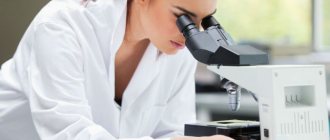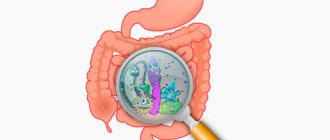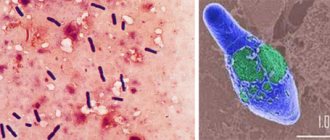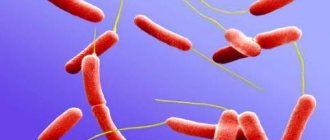Detailed description of the study
The human intestinal microflora is involved in many important processes in the body. It helps digest food debris, produces vitamins and short-chain fatty acids - substances necessary for the functioning of intestinal cells. Thus, the number and composition of intestinal microorganisms is extremely important in maintaining human health.
There is an idea of normal microflora, but norms can vary widely. Each person has a unique composition of intestinal microorganisms. Some of them are classified as eubiotic, or beneficial flora, for example, some types of lacto- and bifidobacteria.
Another part of the microbial community belongs to the opportunistic microbiota. These bacteria do not cause harm to humans until their number increases beyond acceptable limits.
In a healthy intestine, a balance is maintained between eubiotic and opportunistic bacteria. Taking antibiotics, poor nutrition, alcohol abuse, stressful situations and other factors contribute to changes in the qualitative and quantitative composition of the intestinal microflora, that is, an increase in the number of opportunistic microorganisms. This condition is called dysbiosis and can negatively affect the digestive system and other organs.
Manifestations of dysbiosis are not always obvious; sometimes no intestinal symptoms are observed. In other cases, a person notices problems with stool, bloating and excessive gas formation, cramping or stabbing pain in the abdomen.
Stool culture to study the structure of the intestinal microflora allows us to identify the main representatives of opportunistic microflora, such as Staphylococcus aureus (S. aureus), Escherichia, Klebsiella, Enterobacter, Acinetobacter, Proteus , yeast-like fungi (Candida, etc.) and others.
To assess the composition of the microflora, a bacteriological culture of a stool sample provided to the laboratory is carried out. The result is assessed by the presence and number of bacterial colonies that demonstrate growth on the substrate. The test refers to additional methods of examining people suffering from digestive problems, excessive gas formation, and stool disorders.
Rules for collecting stool for sowing tank
Preparation for testing for dysbacteriosis
Biomaterial (feces) for intestinal dysbiosis is collected before the start of treatment with antibacterial and chemotherapeutic drugs. If this is not possible, then the study is carried out no earlier than 12 hours after discontinuation of the drugs. Only freshly excreted feces are collected for research.
3-4 days before the study, it is necessary to stop taking laxatives, castor and petroleum jelly and stop administering rectal suppositories. Feces obtained after an enema, as well as after taking barium (during an X-ray examination), are unsuitable for research.
A special sterile container for collecting stool must be obtained in advance from a patient examination center or pharmacy. First write your data on the label of the stool container: full name, date of birth, date and time of collection of the material. The entry must be made in legible handwriting.
When taking material, sterility must be observed. Before collecting stool, urinate in the toilet and flush. Next, by natural defecation into a bedpan, collect the stool (it is important to ensure that urine does not get in). The bedpan is pre-treated with any disinfectant, thoroughly washed with running water several times and rinsed with boiling water. Feces are taken into the container with a spoon in an amount of no more than 1/3 of the container’s volume.
The material is delivered to any Laboratory Patient Examination Center within 3 hours from the moment of collection .
Attention! There are restrictions on the time and days of receiving biomaterial, please check the information by contact phone numbers.
It is advisable to store the material in the cold for the specified time (for this you can use a cold pack or line the container with ice cubes prepared in advance), but not freeze it.
Attention! Conditions that must be observed: freezing of feces is not allowed, long-term storage is not allowed (more than 5-6 hours), no preservative media other than those indicated are suitable, the container must be tightly closed.
Rules for collecting stool for culture for microflora and sensitivity to antibiotics
Feces are collected for examination before the start of treatment with antibacterial and chemotherapy drugs.
3-4 days before the study, it is necessary to stop taking laxatives, castor and vaseline oil, and stop administering rectal suppositories. Feces obtained after an enema, as well as after taking barium (during X-ray examination) are not accepted for examination!
The day before, the patient must receive a special sterile 30 ml container with a spoon for collecting stool from the Examination Center.
Before collecting stool, you must first urinate in the toilet. Next, by natural defecation, stool is collected into a toilet or bedpan. Then the feces are spooned into a sterile container with a screw cap in an amount of 1–3 g (1 spoon).
Material should be taken from areas where mucus and/or blood is found. Next, screw the lid on the container, write on the container label: Full name, date and time of material collection, type of study. If it is impossible to quickly deliver stool to the Examination Center, the container with stool can be stored in the refrigerator from +2 to +8 ºС for no more than 4 hours.
References
- Quigley, E. Gut bacteria in health and disease. Gastroenterol Hepatol., 2013. - Vol. 9(9). — P. 560-569.
- Fröhlich, E., Farzi, A., Mayerhofer, R. et al. Cognitive impairment by antibiotic-induced gut dysbiosis: Analysis of gut microbiota-brain communication. Brain Behav Immun., 2016. - Vol. 56. - P. 140-155.
- Tomasello, G., Mazzola, M., Leone, A. et al. Nutrition, oxidative stress and intestinal dysbiosis: Influence of diet on gut microbiota in inflammatory bowel diseases. Biomed Pap Med FacUniv Palacky Olomouc Czech Repub., 2016. - Vol. 160(4). — P. 461-466.
What pathogenic microorganisms are most often detected?
A patient with an acute digestive disorder and suspected infection is sent to an inpatient infectious diseases department. Children are hospitalized together with their mothers. In a hospital setting, it is possible to isolate the patient and conduct the most complete examination and treatment.
The most common intestinal pathogens are manifested by the following diseases:
- Dysentery - caused by Shigella, the main “blow” is dealt to the stomach and large intestine. The pathogen is characterized by good adaptability to environmental conditions. They live in garbage and feces for up to two months. A person gets the infection through dirty hands or contaminated food.
- Salmonellosis - the favorite site of infection is the small intestine. The disease is accompanied by severe intoxication. For young children it is especially dangerous because it causes severe complications (pneumonia, meningoencephalitis, general sepsis). Pathogens are divided into types, except for salmonellosis, typhoid fever is caused by infection through the fecal-oral route, through insufficiently processed foods, and dirty water.
- Coli infections are diseases caused by E. coli of different serotypes. Occurs more often in infants. Affects the large intestine. They are transmitted from carriers or sick adults if the basic rules of hygiene and baby care are not followed.
These examples show how important it is to timely analyze not only feces, but also food, drinking water, and swabs from the hands of personnel. Especially if the disease is detected in children's institutions.
What exactly is determined during the analysis process?
The growth of pathogens of dysentery and salmonellosis, if present, is detected. Since special selective media are used specifically for these groups of microorganisms, the growth of other bacteria in this study is unlikely.
Other groups of microorganisms capable of causing acute intestinal infections (for example: pathogenic species of Escherichia coli E. coli) do not grow in this culture.
Laboratory test “DNA of intestinal pathogens in stool: OKI test (Shigella/Salmonella/Campylobacter/Adenovirus/Rotavirus/Norovirus/Astrovirus)”. will allow, along with bacteria, to identify viruses that can cause intestinal infections.
Also, if salmonellosis is suspected, the test “Antibodies to Salmonella (Salmonella) A, B, C1, C2, D, E” in the blood serum is used.
Fecal occult blood test
A fecal occult blood test is intended to diagnose hidden bleeding from the gastrointestinal tract (GIT).
The cause of bleeding in the gastrointestinal tract can be erosive or ulcerative damage to organs, varicose veins, helminthic infestations, tumors, diverticula, polyps, hemorrhoids, etc. The intensity of bleeding varies significantly. The most difficult thing to diagnose is small chronic bleeding, which does not manifest itself clinically for a long time.
A fecal occult blood test is also included in the medical examination program and is carried out once every 2 years, starting at the age of 49, for early diagnosis of colorectal cancer.
The CMD laboratory has two options for testing stool for occult blood:
- A fecal occult blood test is used to diagnose hidden bleeding from the lower gastrointestinal tract. The test is based on the detection of red blood cell hemoglobin in the stool.
- Colon View Hb/Hp is a new generation test based on the detection of hemoglobin and hemoglobin/haptoglobin complex (Hb/Hp). The hemoglobin molecule breaks down as it passes through the gastrointestinal tract, and the hemoglobin-haptoglobin complex is a stable form of hemoglobin, so it can be detected even after a fairly long passage through the intestines. Thus, this test is used for screening examination of all parts of the gastrointestinal tract.
How are results assessed?
The result of the analysis for the intestinal group takes into account the presence of the entire spectrum of microorganisms.
The presence of pathogenic flora is noted separately with pluses on a standard form, recorded with stamps or included in the conclusion before the doctor’s signature
The count is measured in CFU (colony-forming units) per gram of feces. Advanced analysis allows us to judge the presence of dysbiosis among beneficial flora. This point must be taken into account, since it aggravates the course of the disease and requires correction after the acute symptoms subside.
You should not try to decipher the analysis yourself. Even doctors of various specialties not related to infections do not have enough information on this issue. Therefore, only infectious disease specialists, bacteriologists and gastroenterologists can give correct advice and assessment.
Coprogram
A coprogram is a general clinical study that includes the study of physicochemical properties and microscopic examination of feces.
The coprogram allows you to evaluate the function of the stomach and pancreas, liver dysfunction, the speed of food passage through the digestive tract, the presence of inflammatory, destructive changes, and absorption processes in the intestine. A general stool analysis is also informative in the diagnosis of colitis, intestinal infections, and dysbacteriosis.
During the study, it is possible to detect pathological impurities that indicate the presence of a pathological process in the organs of the gastrointestinal tract: ulcerative defects, helminthic infestations, intestinal tuberculosis, disintegrating tumors, etc.
Stool analysis includes assessment of physical properties, chemical analysis and microscopy.
- Physical properties: consistency, shape, color and smell of feces, macroscopic mucus impurities, blood, remains of undigested food.
- Chemical analysis: blood content, bilirubin, stercobilin, leukocytes, pH reaction.
- Microscopy: food residues, epithelium, mucus, crystals, erythrocytes, leukocytes, protozoa, yeast and other indicators.








